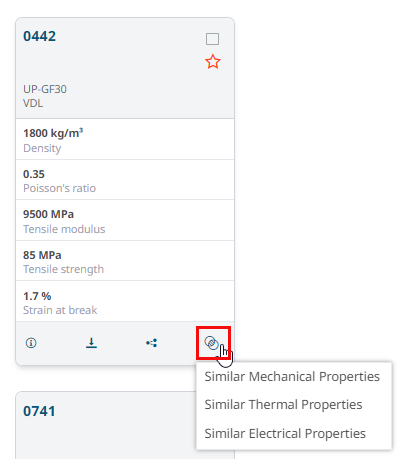Similar Materials
Find similar materials in terms of mechanical, thermal, or electrical properties.
The Similar Properties API is engineered to calculate similarity scores for properties by comparing them to a reference material based on predefined parameters. It employs decay functions to measure the degree of similarity and generate corresponding scores. Each material has specific properties with set values, and by comparing these against the values of a chosen reference material, the API computes a score. This score is then used to rank and present a list of materials similar to the reference material.
To find similar materials:
-
Select a material.
Tip: You can search for reference material from the AMDC filters in the left navigation pane or use Clear All Filters to reset the database before selecting the reference specific material.
-
Click
 and then select a required similar material
property profile.
and then select a required similar material
property profile.
Figure 1. Select Similar Material Property Profile 
A list of materials that share similar mechanical properties is displayed. You will see the corresponding score values that indicate the degree of similarity between the reference material and the similar materials on the list.Material with a higher score have higher similarity to the reference material.
Figure 2. Similar Alternate Materials Result with Score 
Property Profiles for Administrators: The following information describes the concept of Property Profiles for Administrators.
Property Parameters:- Method: Specifies the decay method to be used (e.g., gauss, exp, linear)
- Origin: The original value around which similarity is evaluated
- Value: The value to be scored for similarity
- Offset: Defines the range within which the decay function evaluates similarity
- Scale: Determines the distance at which the computed score equals the decay parameter
- Decay: Defines how input values are scored based on distance from the origin
- Weight: Weight multiplier for the computed score
General Parameters:- Floor: Specifies the minimum score threshold. Scores below this threshold are excluded
- Total Score: Sum of scores divided by sum of weights
Decay Functions:- DECAY_GAUSS(value, origin, scale, offset, decay) → score
- DECAY_EXP(value, origin, scale, offset, decay) → score
- DECAY_LINEAR(value, origin, scale, offset, decay) → score
Scoring:- For each property available for the original material, a score is computed using the decay algorithm.
- The score is multiplied by the weight assigned to that property.
- If no value is available for a property, it scores 0.
- All scores are summed and divided by the sum of weights.
- The result is multiplied by 100 to obtain scores in the range of 0 to 100.
Additional Notes:- If a property cannot be compared due to missing data, it is included with a score of 0.
- If a property does not achieve a score of 1, the overall score will be 0 (knockout).
For example, here is a similar list of material properties profiles used:Table 1. Similar List of Material Properties Profiles Mechanical Properties Thermal Properties Electrical Properties Tensile Modulus Coefficient of linear thermal expansion, parallel Relative Permittivity 100MHZ Yield Stress Vicat softening temperature A Relative Permittivity 1MHZ Yield Strain Vicat softening temperature B Dissipation Factor 100Hz Stress at break Temp. of deflection under load Dissipation Factor 60Hz Strain at break Coefficient thermal expansion Dissipation Factor 1MHz Charpy Impact strength Transition temperature Volume Resistivity Charpy Notched Impact Strength Burning behavior Surface Resistivity